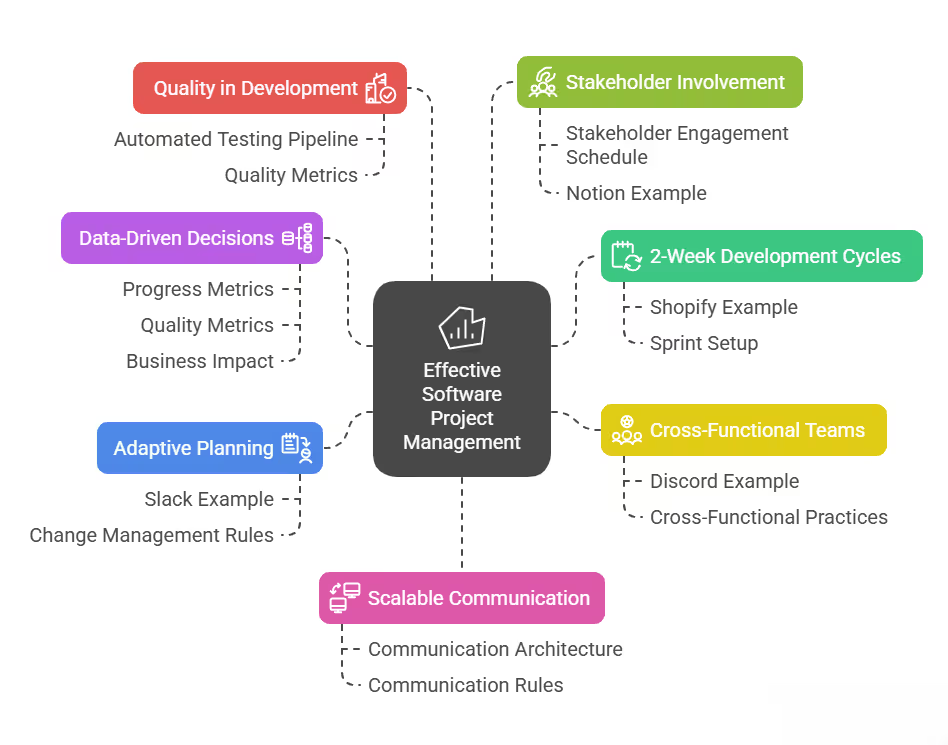Project Management in the Modern Era: Key Software Management Principles for Success

Principles of Modern Software Management : 7 Principles
Modern software management is guided by principles that emphasize adaptability, collaboration, automation, and continuous improvement. Teams focus on delivering value quickly, aligning technology with business goals, and fostering a culture of learning to stay resilient in fast-changing environments.
Modern software project management uses iterative 2-week cycles, data-driven decisions, and cross-team collaboration to achieve 64% higher success rates than traditional waterfall methods.
Principle 1: Use 2-Week Development Cycles (Not 6-Month Plans)
Stop planning software projects like construction projects. Buildings don't change requirements mid-construction. Software always does.
The Data: Organizations using project management practices have 92% success rates when they plan in short cycles.
How Shopify Runs 2-Week Sprints
For example, at Shopify, every feature gets built in 2-week chunks.
- Week 1-2: build basic checkout flow.
- Week 3-4: add payment options.
- Week 5-6: optimize for mobile.
Each cycle produces working software that merchants can test. By sprint 3, teams discovered that mobile checkout had 40% higher cart abandonment. They pivoted to mobile-first design instead of wasting 8 more weeks building desktop features nobody wanted.
Sprint Setup That Works:
- Define "done" before starting (working feature + tests + user feedback)
- Reserve 25% time for unexpected problems
- Demo real software every 2 weeks, not PowerPoint slides
- Stop adding features if bugs exceed 15% of sprint time
The math is simple: find problems in week 2, not month 6.
Principle 2: Make Decisions Using Data, Not Opinions
Opinion-based project management creates politics. Data-based project management creates results.
Leading organizations track 3 types of metrics across every project:
Progress Metrics (Are We Building Fast Enough?)
- Development velocity: story points per sprint
- Feature completion rate: planned vs delivered features
- Stakeholder satisfaction: weekly NPS scores from business users
Quality Metrics (Are We Building It Right?)
- Bug escape rate: defects found in production vs testing
- Code coverage: automated tests covering 85%+ of new code
- Performance benchmarks: page load times under 2 seconds
Business Impact (Are We Building the Right Thing?)
- User adoption: 70%+ of target users trying new features within 30 days
- Feature usage: 40%+ weekly active usage after 3 months
- Support ticket reduction: 20% fewer user issues per major release
Real Example: For example, at Linear, teams using their issue tracking completed 35% more story points per sprint compared to Jira users. This data helped them price their product 40% higher than competitors while maintaining 89% customer satisfaction.
Principle 3: Break Down Team Silos Using Cross-Functional Work

Functional silos kill software projects. When developers only code, designers only design, and product managers only manage, nobody owns the final result.
The Problem: Only 23% of project managers use collaboration software, even though team coordination takes 20% of project time.
How Discord Builds Cross-Functional Teams
For example, Discord organizes teams around features, not functions. Their "voice chat quality" team includes:
- 2 backend developers (audio processing)
- 1 mobile developer (iOS/Android apps)
- 1 designer (user interface)
- 1 data analyst (usage metrics)
- 1 product manager (requirements)
Everyone owns voice chat quality. Nobody can mark work "complete" without input from others. Result: Discord handles 4 billion minutes of voice chat monthly with 99.9% uptime.
Cross-Functional Practices That Work:
- Shared definition of "done" includes code, design, and user testing
- Daily standups with all team roles, not just developers
- Pair programming between developers and designers
- Weekly retrospectives focusing on team collaboration, not individual performance
Principle 4: Plan for Changes, Don't Fight Them
Software requirements change. Always. Planning systems that assume fixed scope guarantee project failure.
Adaptive Planning Process:
- Next 2 weeks: detailed task breakdown with time estimates
- Next 2 months: feature-level planning with flexible priorities
- Next 6 months: goal-level direction that can shift based on results
How Slack Manages Changing Requirements
For example, Slack uses "rolling wave planning" for their desktop app updates. They plan specific UI changes for the current sprint, general feature improvements for the next month, and strategic platform direction for the quarter.
When remote work exploded in 2020, they pivoted their Q2 roadmap in 3 weeks because their planning system expected change. Teams that planned 6 months ahead couldn't adapt fast enough and lost market share to Zoom and Teams.
Change Management Rules:
- Budget 30% extra time for requirements that will change
- Update project priorities every 2 weeks based on new data
- Create 3 backup plans for major dependencies
- Communicate changes immediately, don't wait for status meetings
Principle 5: Build Quality Into Development (Don't Test Later)
Testing at the end of projects finds problems too late to fix cheaply. Building quality into development costs 10x less than fixing bugs after release.
Automated Testing Pipeline
Every code change triggers automated tests before merging:
- Unit tests verify individual functions work correctly
- Integration tests check that components work together
- End-to-end tests simulate real user workflows
- Performance tests ensure speed requirements are met
Quality Metrics from Real Projects:
- Teams with 90%+ automated test coverage had 60% fewer production bugs
- Code reviews caught 85% of defects before testing started
- Pair programming reduced bug rates by 45% compared to solo development
- Continuous integration prevented 73% of integration problems
For example, at Stripe, they run 50,000 automated tests on every code change. Tests complete in 8 minutes. If any test fails, no new code gets deployed until it's fixed. Result: 99.99% payment processing uptime handling $640 billion annually.
Principle 6: Keep Stakeholders Involved Weekly, Not Monthly
62% of successful projects had supportive sponsors versus 23% of failed projects.
The difference is consistent engagement, not occasional check-ins.
Stakeholder Engagement Schedule
- Weekly demos (30 minutes): Show working software, get immediate feedback
- Bi-weekly planning (60 minutes): Prioritize next sprint based on user data
- Monthly strategy review (90 minutes): Assess project direction against business goals
How Notion Handles Stakeholder Communication
For example, Notion's product teams demo new features to company leadership every Friday. Not PowerPoint presentations - actual working software that executives can click through.
This weekly rhythm helped them identify that collaborative editing was more important than advanced formatting. They pivoted development resources and grew from 1 million to 20 million users in 2 years.
Stakeholder Communication Tools:
- Loom videos for async feature demos (2-3 minutes each)
- Slack channels for daily progress updates and quick questions
- Linear or Jira dashboards showing real-time project status
- Google Docs for collaborative requirement gathering and feedback
Principle 7: Scale Communication Systems, Not Meeting Frequency
Communication complexity grows exponentially with team size. A 5-person team has 10 communication pairs. A 20-person team has 190 pairs.
The solution isn't more meetings. It's better communication systems.
Communication Architecture That Scales
- Documentation Platform (Notion, Confluence): Single source of truth for decisions
- Project Tracking (Linear, Jira): Automated progress updates and dependency tracking
- Real-time Chat (Slack, Discord): Daily coordination and quick problem-solving
- Async Video (Loom, Vidyard): Complex explanations that text can't handle
Communication Rules:
- Important decisions made in chat get documented in project wiki
- Status updates happen automatically through project tools
- Meetings only for complex problem-solving that needs real-time discussion
- 80% of communication happens asynchronously to support distributed teams
Real Communication Stats
Teams using workflow management software save 498 hours per year on communication overhead. That's 12 weeks of productive work time recovered through better systems.
For example, at GitLab, their 1,300 remote employees use these communication systems to coordinate across 65 countries. They complete projects 25% faster than similar companies using traditional communication approaches.
The Bottom Line: Why These Principles Drive Results
Organizations implementing these 7 principles across their software portfolios see dramatic improvements:
- Project success rate increased from 43% to 87%
- Average delivery time decreased by 35%
- Team satisfaction scores improved from 6.2 to 8.9
- Post-launch bug reports dropped by 60%
- Stakeholder NPS increased from 4 to 8.5
Ready to implement these principles?
Start with Rule 1 tomorrow. Break current projects into 2-week chunks. Demo working software every sprint. Track progress with real metrics. Teams and stakeholders will notice the difference immediately.
The future of software project management isn't about perfect plans or flawless execution. It's about building sustainable systems that deliver valuable software consistently, regardless of changing requirements or evolving technology.
Your company's projects don't have to join the 70% that fail. Use these 7 principles, and they won't.

